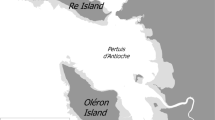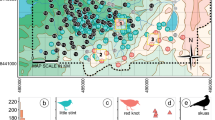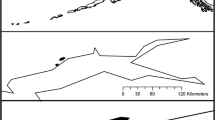Abstract
Sub-arctic environments are undergoing rapid changes. For instance, woody shrubs are encroaching into previously open habitats, and booming goose (Chen caerulescens and Branta canadensis) populations are creating vast areas of bare mud. Across the region, these changes are likely to diminish the amount and quality of breeding habitat for imperiled arctic- and sub-arctic-breeding shorebirds, including the Hudsonian Godwit (Limosa haemastica). We studied godwit nest site selection at two study areas—Churchill, Manitoba, Canada, and Beluga River, Alaska, USA—to identify differences in habitat preferences between the two populations and determine the degree to which each avoided woody vegetation and non-vegetated areas. We used multivariate analyses to evaluate differences in microhabitat between nest sites and random sites within and between each study area. Godwits at both areas selected nest sites characterized by higher amounts of graminoid and shrubby cover with fewer non-vegetated areas than random locations. Habitat attributes preferred by godwits are expected to become less available as the climate changes and as geese continue to degrade arctic and sub-arctic ecosystems.


Similar content being viewed by others
References
Abraham KF, Jefferies RL, Alisauskas RT (2005a) The dynamics of landscape change and snow geese in mid-continent North America. Global Change Biol 11:841–855
Abraham KF, Jefferies RL, Rockwell RF (2005b) Goose-induced changes in vegetation and land cover between 1976 and 1997 in an Arctic coastal marsh. Arct Antarct Alp Res 37:269–275
Alisauskas RT, Rockwell RF, Dufour KW, Cooch EG, Zimmerman G, Drake KL, Leafloor JO, Moser TJ, Reed ET (2011) Harvest, survival, and abundance of midcontinent lesser snow geese relative to population reduction efforts. Wildlife Monogr 179:1–42
Andres BA, Smith PA, Morrison RG, Gratto-Trevor CL, Brown SC, Friis CA (2012) Population estimates of North American shorebirds, 2012. Wader Study Group Bull 119:178–194
Ballantyne K, Nol E (2011) Nesting habitat selection and hatching success of Whimbrels near Churchill, Manitoba, Canada. Waterbirds 34:151–159
Ballantyne K, Nol E (2015) Localized habitat change near Churchill, Manitoba and the decline of nesting Whimbrels (Numenius phaeopus). Polar Biol 38:529–537
Bart J, Brown S, Harrington B, Morrison RIG (2007) Survey trends of North American shorebirds: population declines or shifting distributions? JAvian Biol 38:73–82
Battin J (2004) When good animals love bad habitats: ecological traps and the conservation of animal populations. Conserv Biol 18:1482–1491
Block WM, Brennan LA (1993) The habitat concept in ornithology: theory and applications. In: Power DM (ed) Current Ornithology, vol 11. Plenum Press, NY, pp 35–91
Boyd H, Smith GJ, Cooch FG (1982) The lesser snow goose of the eastern Canadian Arctic: their status during 1964–1979 and their management from 1982 to 1990. Can Wildl Serv Occas Paper 46:1–21
Brown S, Hickey C, Harrington B, Gill RE Jr (2001) United States shorebird conservation plan, 2nd edn, Manomet Center for Conservation Sciences, Manomet
Bunn AG, Goetz SJ (2006) Trends in satellite-observed circumpolar photosynthetic activity from 1982 to 2003: the influence of seasonality, cover type, and vegetation density. Earth Interact 10:1–19
Burger J (1987) Physical and social determinants of nest-site selection in Piping Plover in New Jersey. Condor 89:811–818
Caccianiga M, Payette S (2006) Recent advance of white spruce (Picea glauca) in the coastal tundra of the eastern shore of Hudson Bay (Québec, Canada). J Biogeogr 33:2120–2135
Chapin FS, Shaver GR, Giblin AE, Nadelhoffer KJ, Laundre JA (1995) Responses of arctic tundra to experimental and observed changes in climate. Ecology 76:694–711
Colwell MA, Oring LW (1990) Nest-site characteristics of prairie shorebirds. Can J Zoolog 68:297–302
Cotter RC, Hughes RJ, May P, Novalinga P, Johannes J, Hindman LJ, Padding PI (2013) Breeding biology of Atlantic population of Canada Geese in Nunavik, Northern Québec. Arctic 66:301–311
Danby RK, Hik DS (2007) Variability, contingency and rapid change in recent subarctic alpine tree line dynamics. J Ecol 95:352–363
Davis JM, Stamps JA (2004) The effect of natal experience on habitat preferences. Trends Ecol Evol 19:411–416
Filzmoser P, Gschwandtner M (2015) Multivariate Outlier Detection Based on Robust Methods, package ‘mvoutlier’
Genz A, Bretz F, Miwa T, Mi X, Leisch F, Scheipl F, Bornkamp B, Maechler M, Hothorn T (2015) Multivariate Normal and t Distributions: Package ‘mvtnorm’
Goetz SJ, Bunn AG, Fiske GJ, Houghton RA (2005) Satellite-observed photosynthetic trends across boreal North America associated with climate and fire disturbance. P Natl Acad Sci USA 102:13521–13525
Götmark F, Blomqvist D, Johansson OC, Bergkvist J (1995) Nest site selection: a trade-off between concealment and view of the surroundings? J Avian Biol 26:305–312
Hagar JA (1966) Nesting of Hudsonian Godwit at Churchill, Manitoba. Living Bird 5:5–43
Harwood CM (2014) Intraseason re-use of Numenius nest by Limosa. Wader Study Group Bull 121:199–200
IPCC Climate Change (2013) The physical science basis. Available at: http://www.ipcc.ch/ipccreports/ar4-wg1.htm
Iverson SA, Gilchrist HG, Smith PA, Gaston AJ, Forbes MR (2014) Longer ice-free seasons increase the risk of nest depredation by polar bears for colonial breeding birds in the Canadian Arctic. P Roy Soc Lond B Bio 281:20133128
Jefferies RL, Rockwell RF (2002) Foraging geese, vegetation loss and soil degradation in an Arctic salt marsh. Appl Veg Sci 5:7–16
Kaplan JO, New M (2006) Arctic climate change with a 2 °C global warming: timing, climate patterns and vegetation change. Clim Change 79:213–241
Kentie R, Both C, Hooijmeijer JC, Piersma T (2015) Management of modern agricultural landscapes increases nest predation rates in Black-tailed Godwits Limosa limosa. Ibis 157:614–625
Kutz SJ, Hoberg EP, Polley L, Jenkins EJ (2005) Global warming is changing the dynamics of Arctic host–parasite systems. P Roy Soc Lond B Bio 272:2571–2576
Liebezeit JR, Kendall SJ, Brown S, Johnson CB, Martin P, McDonald TL, Payer DC, Rea CL, Streever B, Wildman AM, Zack S (2009) Influence of human development and predators on nest survival of tundra birds, Arctic Coastal Plain, Alaska. Ecol Appl 19:1628–1644
Martin TE (1993) Nest predation and nest sites: new perspectives on old patterns. Bioscience 43:523–532
Martin TE (2001) Abiotic vs. biotic influences on habitat selection of coexisting species: climate change impacts? Ecology 82:175–188
Metcalfe NB (1984) The effects of habitat on the vigilance of shorebirds: is visibility important? Anim Behav 32:981–985
Myneni RB, Keeling CD, Tucker CJ, Asrar G, Nemani RR (1997) Increased plant growth in the northern high latitudes from 1981 to 1991. Nature 386:698–702
Newton I (1998) Population limitation in birds. Academic Press, San Diego
Parmesan C, Yohe G (2003) A globally coherent fingerprint of climate change impacts across natural systems. Nature 421:37–42
Peterson SL, Rockwell RF, Witte CR, Koons DN (2013) The legacy of destructive Snow Goose foraging on supratidal marsh habitat in the Hudson Bay lowlands. Arct Antarct Alp Res 45:575–583
Piersma T, Lindström à (2004) Migrating shorebirds as integrative sentinels of global environmental change. Ibis 146:61–69
Post E, Forchhammer MC, Bret-Harte MS, Callaghan TV, Christensen TR, Elberling B, Fox AD, Gilg O, Hik DS, Høye TT, Ims RA, Jeppesen E, Klein DR, Madsen J, McGuire AD, Rysgaard S, Schindler DE, Stirling I, Tamstorf MP, Tyler NJC, van der Wal R, Welker J, Wookey PA, Schmidt NM, Aastrup P (2009) Ecological dynamics across the Arctic associated with recent climate change. Science 325:1355–1358
Prop J, Aars J, Bårdsen BJ, Hanssen SA, Bech C, Bourgeon S, de Fouw J, Gabrielsen GW, Lang J, Noreen E, Oudman T, Sittler B, Stempniewicz L, Tombre I, Wolters E, Moe B (2015) Climate change and the increasing impact of polar bears on bird populations. Front Ecol Evol 3:33
R Development Core Team (2015) R: a language and environment for statistical computing. R Foundation for Statistical Computing, Vienna
Ramsay RJ, Otter K, Ratcliffe LM (1999) Nest-site selection by Black-capped Chickadees: settlement based on conspecific attraction. Auk 116:604–617
Restani M, Marzluff JM, Yates RE (2001) Effects of anthropogenic food sources on movements, survivorship, and sociality of common ravens in the arctic. Condor 103:399–404
Rodrigues R (1994) Microsite variables influencing nest-site selection by tundra birds. Ecol Appl 4:110–116
Saalfeld ST, Lanctot RB, Brown SC, Saalfeld DT, Johnson JA, Andres BA, Bart JR (2013) Predicting breeding shorebird distributions on the Arctic Coastal Plain of Alaska. Ecosphere 4:16
Sammler JE, Andersen DE, Skagen SK (2008) Population trends of tundra-nesting birds at Cape Churchill, Manitoba, in relation to increasing goose populations. Condor 110:325–334
Schuur EA, Crummer KG, Vogel JG, Mack MC (2007) Plant species composition and productivity following permafrost thaw and thermokarst in Alaskan tundra. Ecosystems 10:280–292
Senner NR (2010) Conservation Plan for the Hudsonian Godwit. Version 1.16. Manomet Center for Conservation Science, Manomet
Senner NR, Hochachka WM, Fox JW, Afanasyev V (2014) An exception to the rule: carry-over effects do not accumulate in a long-distance migratory bird. PLoS One 9:e86588
Senner NR, Stager M, Sandercock BK (2016) Ecological mismatches are moderated by local conditions for two populations of a long-distance migratory bird. Oikos 125
Skrade PDB, Dinsmore SJ (2013) Egg crypsis in a ground-nesting shorebird influences nest survival. Ecosphere 4:151
Smith LC, Sheng Y, MacDonald GM, Hinzman LD (2005) Disappearing arctic lakes. Science 308:1429
Smith PA, Gilchrist HG, Smith JNM (2007) Effects of nest habitat, food, and parental behavior on shorebird nest success. Condor 109:15–31
Smith PA, Elliott KH, Gaston AJ, Gilchrist HG (2010) Has early ice clearance increased predation on breeding birds by polar bears? Polar Biol 33:1149–1153
Sokal RR, Rohlf FJ (1995) Biometry: the principles and practice of statistics in biological research. Freeman, NY
Stow DA, Hope A, McGuire D, Verbyla D, Gamon J, Huemmrich F, Houston S, Racine C, Sturm M, Tape K, Hinzman L, Yoshikawa K, Tweedie C, Noyle B, Silapaswan C, Douglas D, Griffith B, Jia G, Epstein H, Walker D, Daeschner S, Petersen A, Zhou L, Myneni R (2004) Remote sensing of vegetation and land-cover change in Arctic tundra ecosystems. Remote Sens Environ 89:281–308
Sturm M, Racine C, Tape K (2001) Climate change - increasing shrub abundance in the Arctic. Nature 411:546–547
Sturm M, Douglas T, Racine C, Liston GE (2005a) Changing snow and shrub conditions affect albedo with global implications. J Geophys Res 110:G01004
Sturm M, Schimel J, Michaelson G, Romanovsky VE, Welker JM, Oberbauer SF, Liston GE, Fahnestock J (2005b) Winter biological processes could help convert arctic tundra to shrubland. Bioscience 55:17–26
Swift RJ (2016) Nest site selection in Hudsonian Godwits: effects of habitat and predation risk. MS Thesis, Cornell University
Tape K, Sturm M, Racine C (2006) The evidence for shrub expansion in northern Alaska and the pan-Arctic. Global Change Biol 12:686–702
Tulp I, Schekkerman H, de Leeuw J (2012) Eggs in the freezer: energetic consequences of nest site and nest design in Arctic breeding shorebirds. PLoS One 7:e38041
Viereck LA, Dyrness CT, Batten AR, Wenzlick KJ (1992) The Alaska vegetation classification. US Department of Agriculture, Forest Service, Pacific Northwest Research Station, Portland
Walker BM, Senner NR, Elphick CS, Klima J (2011) Hudsonian Godwit (Limosa haemastica), The birds of North America Online (A. Poole, Ed.). Ithaca: Cornell Lab of Ornithology; Retrieved from the Birds of North America Online: http://bna.birds.cornell.edu/bna/species/629. Accessed 28 Aug 2016
Wauchope HS, Shaw JD, Varpe Ø, Lappo EG, Boertmann D, Lanctot RB, Fuller RA (2016) Rapid climate-driven loss of breeding habitat for Arctic migratory birds. Global Change Biol 23:1085–1094
Wolken JM, Hollingsworth TN, Rupp TS, Chapin FS, Trainor SF, Barrett TM, Sullivan PF, McGuire AD, Euskirchen ES, Hennon PE, Beever EA, Conn JS, Crone LK, D’Amore DV, Fresco N, Hanley TA, Kielland K, Kruse JJ, Patterson T, Schuur EAG, Verbyla DL, Yarie J (2011) Evidence and implications of recent and projected climate change in Alaska’s forest ecosystems. Ecosphere 2:1–35
Yoshikawa K, Hinzman LD (2003) Shrinking thermokarst ponds and groundwater dynamics in discontinuous permafrost near Council, Alaska. Permafrost Periglac 14:151–160
Acknowledgements
We thank W. Abbott, A. Alstad, H. Batcheller, S. Billerman, B. Davis, J. DeCoste, D. Gochfeld, M. Harvey, J. Heseltine, M. Hilchey, A. Johnson, T. Johnson, J. Karagicheva, J. Klarevas-Irby, B. Lagasse, G. MacDonald, J. Marion, M. McConnell, J. McGowan, K. Parkinson, B. Schultz, G. Seeholzer, H. Specht, and B. Walker for their efforts in the field. J. Fitzpatrick and W. Koenig provided valuable comments on earlier drafts of this manuscript. Funding was provided by the David and Lucile Packard Foundation, U.S. Fish and Wildlife Service, Faucett Family Foundation, National Science Foundation, Cornell Lab of Ornithology, Cornell University, Athena Fund of the Cornell Lab of Ornithology, American Museum of Natural History, Ducks Unlimited Canada, Churchill Northern Studies Centre, and Arctic Audubon Society. All procedures performed in this study involving animals were in accordance with the ethical standards of Cornell University.
Author information
Authors and Affiliations
Corresponding author
Ethics declarations
Conflict of interest
The authors declare that they have no conflict of interest.
Rights and permissions
About this article
Cite this article
Swift, R.J., Rodewald, A.D. & Senner, N.R. Breeding habitat of a declining shorebird in a changing environment. Polar Biol 40, 1777–1786 (2017). https://doi.org/10.1007/s00300-017-2101-8
Received:
Revised:
Accepted:
Published:
Issue Date:
DOI: https://doi.org/10.1007/s00300-017-2101-8




